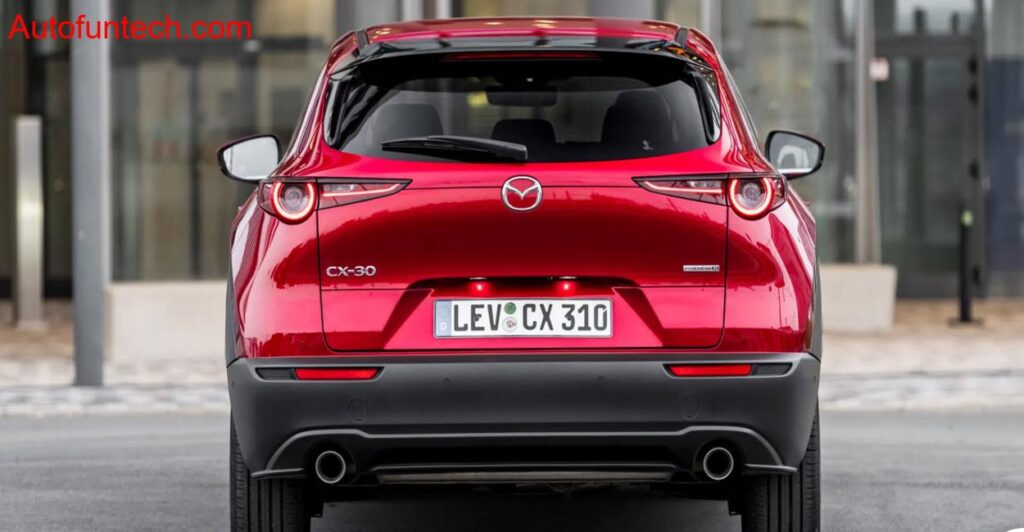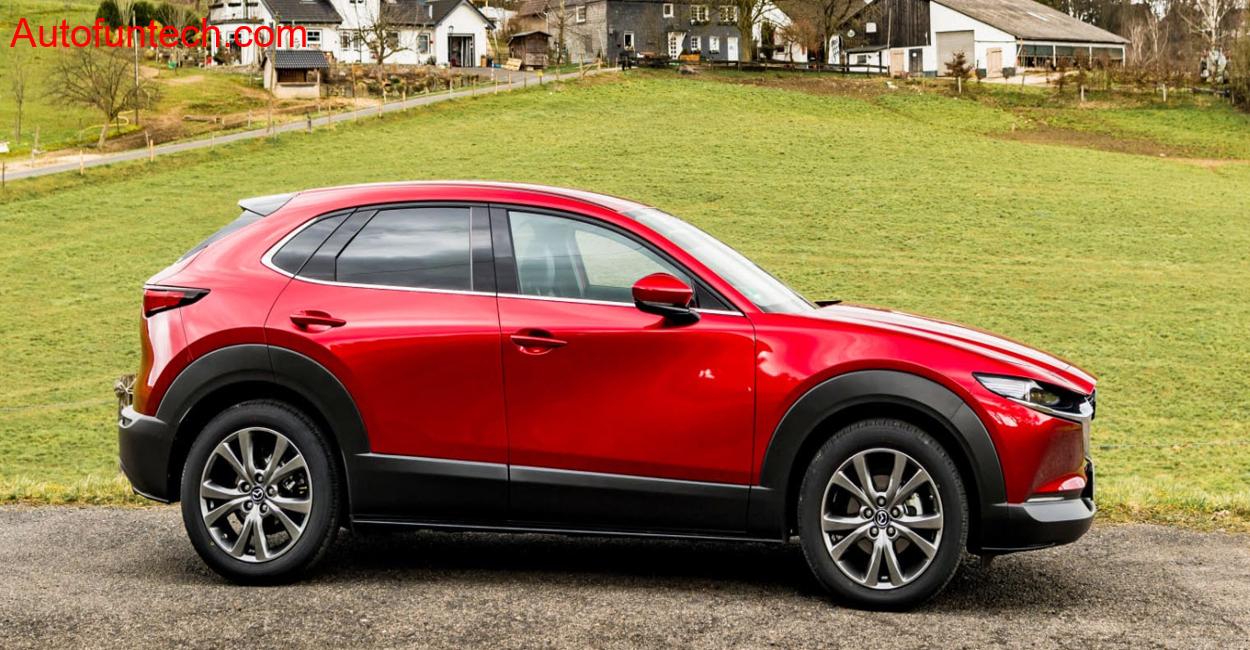When you drive up into the mossy, forest-flanked routes of Gatterberge, a town folded quietly into central Germany’s Harz foothills, you understand what kind of car thrives here. The weather changes on a whim. Roads twist and stretch over undulating terrain, and every turn asks your car whether it’s truly tuned for real-world driving, not just showroom specs.
So naturally, I brought the updated 2025 Mazda CX-30 here to see if Mazda’s quirkiest compact SUV could live up to its promise of dynamism, frugality, and “Jinba Ittai”, the philosophy of horse and rider as one.
This wasn’t a quick press drive. I lived with the car for four days across everything Gatterberge could throw at it, wet cobbled streets, sudden bursts of Alpine drizzle, steep descents through pine tunnels, and a few wide, flat autobahn stretches. The CX-30 had a lot to prove.
Quirky Engineering Meets Real-World Driving
The very first thing that hits you about the 2025 Mazda CX-30 is that it feels… deliberate. Unlike many crossovers which have become faceless blobs of function over flair, the CX-30 is charmingly eccentric. The bodywork’s Soul Red Crystal paint pops even under Gatterberge’s perennially overcast skies. It looks tailored, sleek, almost coupe-like in silhouette, yet it stands on SUV proportions.
The updated model year doesn’t try to wow with drastic cosmetic overhauls. Instead, it refines what already worked. Now, Amazon Alexa integration, a sharper infotainment interface, and real-time traffic with online map updates are all standard. And finally, Mazda includes a touchscreen when you’re stationary (yes, you still need to use the rotary dial on the move, more on that later).
But let’s talk drivetrain. Because here’s where Mazda’s stubborn brilliance truly lives.

The New 2.5L Base Petrol: Big Displacement, Old School Spirit
Our test car came equipped with the all-new base engine: a naturally aspirated 2.5-liter e-Skyactiv-G unit producing 140 hp. It replaces the old 2.0L 122 hp motor, and on paper, it looks refreshing, no turbo, large displacement, and a decent 238 Nm of torque.
But you need to drive it to really grasp Mazda’s intent.
On tight uphill curves in Gatterberge, the engine responded linearly, clean throttle, no lag, and a predictably rising powerband. However, torque is only really alive above 3,000 rpm. Below that, especially on second-gear climbs, you feel it gasping a little.
I loved rowing through the six-speed manual, crisp, short throws, tactile and mechanical in the best way. But our test car came with the automatic, and unfortunately, this is where the charm wanes. Gear changes are noticeable, the ratios are wide, and downshifts on inclines came with a jerk that broke the car’s otherwise smooth demeanor. It’s not a transmission that flatters the motor’s character.
There’s also cylinder deactivation, which cuts two cylinders when cruising. Clever? Sure. Noticeable? Slightly. Effective? Eh, we averaged 7.2 liters per 100km over our mixed test route, which isn’t bad, but it’s not stellar either. On the autobahn at 140 km/h, it drank closer to 8.5 L/100km.
Skyactiv-X: Mazda’s Diesel-Gasoline Chimera
Now here’s where the real geekery comes in. Mazda still offers the Skyactiv-X powertrain, a petrol engine with compression ignition, working partially like a diesel. It runs a leaner mixture, reducing fuel consumption and emissions.
I had the chance to briefly swap into a Skyactiv-X equipped CX-30 on day three of testing, and the difference was subtle but clear. Power delivery is smoother. Torque builds earlier. The car feels less stressed under acceleration, especially when overtaking.
It’s the smarter engine for long-distance drivers, and while the previous version managed 6.4 L/100km, Mazda claims the latest tweaks (in piston design, ignition range, and control systems) bring it closer to 5.9 L. On those scenic but endless B-roads through forested Gatterberge, it simply made more sense.
Still, purists may find it too polite. It doesn’t roar or complain. It hums, it flows, but it doesn’t thrill.
Size That Serves or Limits? The CX-30’s Cabin Conundrum
The CX-30 is smaller than the CX-5, and you feel it, both in the best and worst ways. At 4.4 meters in length, it’s an absolute joy to maneuver through tight village alleys. Parking near the trailhead cafes in Gatterberge was stress-free, even in the rain.
But inside? The rear bench is cramped. I’m 1.73 meters tall, and sitting behind a driver of equal height, my knees were brushing the seatback. Headroom is decent thanks to the sunroof cutout, but shoulder space is tight. It’s not a car for five adults.
The trunk? With seats up, just 265 liters. That’s hatchback territory. We fit two duffel bags and a small tripod case, but a stroller or large suitcase would be a challenge. Fold the rear seats, and things improve to nearly 1,000 liters, plus there’s a clever underfloor bin for stashing tools or groceries.
If you have kids under ten, it works. If you’re hauling IKEA furniture, it won’t.
Driving Character: Poise Over Plushness
What’s truly lovely about the CX-30 is how it rides. It feels well-composed, not overly soft, not uncomfortably firm. On Gatterberge’s broken backroads, it didn’t float or wallow. It just dealt with it. You feel the imperfections, but they’re never jarring. There’s a kind of mechanical honesty here.
The steering is nicely weighted, giving genuine feedback through winding descents. There’s body roll, sure, but it’s predictable and well-contained. Cornering at speed in the rain didn’t unsettle the car, and ESC only subtly intervened when I got a bit overzealous on a downhill chicane.
Noise insulation is excellent. You hear some wind past 120 km/h, but no squeaks, no rattles, no loose plastics. In a town where every café wall echoes with the sound of passing cars, the CX-30 passed by like a whisper.
Cabin Quality: Punches Above Its Price Tag
Mazda continues to impress with its interior game. You sit in what feels like a boutique hotel lounge, not a budget crossover. The materials are genuinely plush, soft-touch leatherette on the dash, tactile knurled knobs, and one of the cleanest HVAC setups in the segment.
The infotainment screen is crisp, and thankfully, Mazda has added proper touchscreen functionality when stationary. But you’ll mostly use the rotary controller, and I love it. It’s precise, intuitive, and doesn’t require you to take your eyes off the road. Voice commands via Alexa were responsive, and Apple CarPlay connected wirelessly without hiccup.
Features-wise, this little SUV is fully loaded: adaptive cruise control, a full-color head-up display, blind spot monitoring, full LED lighting, and even traffic sign recognition. At this price point, it’s nearly unmatched.
Mazda CX-30 2025 Technical Specifications
| Specification | Detail |
|---|---|
| Engine Options | 2.5L e-Skyactiv-G (140 hp), 2.0L Skyactiv-X |
| Power Output | 140 hp @ 6,000 rpm |
| Torque | 238 Nm @ 3,300 rpm |
| Transmission Options | 6-speed manual / 6-speed automatic |
| Drivetrain | FWD or optional AWD |
| 0–100 km/h Acceleration | 9.1 seconds (manual) |
| Fuel Consumption (Combined) | 7.3 L/100km (e-Skyactiv), 5.9 L/100km (Skyactiv-X) |
| CO₂ Emissions | 133–152 g/km |
| Length | 4,395 mm |
| Width | 1,795 mm |
| Height | 1,540 mm |
| Trunk Volume | 265 – 980 liters + 45L underfloor |
| Price (Germany) | Starting from €28,500 |
Final Thoughts: A Car for Drivers Who Appreciate Character
The 2025 Mazda CX-30 isn’t the most spacious, the fastest, or the most frugal SUV in its class. But after 500 kilometers through the vivid greens and grey clouds of Gatterberge, I couldn’t help but admire its commitment to doing things differently.
It offers a driving experience that’s confident and involved. It’s packed with thoughtful tech. It feels premium without screaming about it. And it doesn’t follow the turbocharged herd, it dances to its own rhythm.
If you’re someone who values style, tactile quality, and a bit of driving joy in your daily commute, the CX-30 is a refreshing alternative. It asks you to engage, not just with the road, but with the car itself.


Leave a Comment